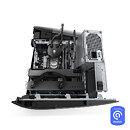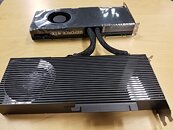Monday, May 18th 2020

Asetek Unveils Rad Card Industry's First Slot-In PCIe Radiator Card
Asetek, the creator of the all-in-one (AIO) liquid cooler and the global leader in liquid cooling solutions for gaming PCs and DIY enthusiasts, today announced its Rad Card GPU Cooler, bringing liquid cooled GPUs to space constrained PC cases. Asetek's Rad Card GPU Cooler, the industry's first slot-in PCIe radiator card, is first available in Dell-Alienware's newly introduced Alienware Aurora R11 PC.
Space concerns are a real issue for PC manufacturers, leaving GPU air cooling as the only option, until now. Asetek took this challenge head-on, innovating a new approach to radiator technology that reimagines the shape and location of the radiator. The Asetek Rad Card GPU Cooler fits into your motherboard's PCIe slot, just like any other add-in card. By utilizing PCIe slots, Asetek has defined a way to overcome PC manufacturers' dilemma of finding additional space inside the case for a liquid cooled GPU heat exchanger (HEx).
Update May 18th: This card may not be limited to just OEMs with Asetek tweeting "Not all of them made it to Alienware. Not what to do with these...". Asetek is very open about seeking feedback and is watching demand for this product from consumers, possibly even getting ready for a giveaway so it will be exciting to see what comes from this.The unique design of Asetek's Rad Card GPU Cooler provides numerous benefits:
Sources:
Asetek, @Asetek
Space concerns are a real issue for PC manufacturers, leaving GPU air cooling as the only option, until now. Asetek took this challenge head-on, innovating a new approach to radiator technology that reimagines the shape and location of the radiator. The Asetek Rad Card GPU Cooler fits into your motherboard's PCIe slot, just like any other add-in card. By utilizing PCIe slots, Asetek has defined a way to overcome PC manufacturers' dilemma of finding additional space inside the case for a liquid cooled GPU heat exchanger (HEx).
Update May 18th: This card may not be limited to just OEMs with Asetek tweeting "Not all of them made it to Alienware. Not what to do with these...". Asetek is very open about seeking feedback and is watching demand for this product from consumers, possibly even getting ready for a giveaway so it will be exciting to see what comes from this.The unique design of Asetek's Rad Card GPU Cooler provides numerous benefits:
- Space: Rad Card enables a liquid cooled GPU in a chassis where space is constrained, while leaving room for a liquid cooled CPU in the same case.
- Performance: In space constrained PC cases, Rad Card provides superior cooling over an air-cooled GPU, ensuring GPU stability and limiting thermal throttling.
- Aesthetics: Rad Card eliminates the hassle and clutter of tube routing for a clean and sparse system environment.




59 Comments on Asetek Unveils Rad Card Industry's First Slot-In PCIe Radiator Card
I wouldn't have a problem if Asstek would innovate instead of just charging those fat patent dollars for the old ass and crap design. Innovate once and sue for the next few decades...
The result is there's not many options for a big company in North America. They get one choice and shit performance. :laugh:
Trying to cool 250W with a single-fan, dual-slot blower is going to be disappointingly noisy - but the same design can dissipate 125W in almost total silence - so think of this radiator as proving at least an additional 125W TDP without adding any extra noise. The product image seems to show that the GPU board itself has some cooling (there are vents in the IO plate) so the radiator should theoretically add quiet cooling for an additional 125W on top of whatever the GPU can already provide.
Swiftech had to scrap their original design, and had to make it use DDC pump in the stack. This is because the pump can't be integral to the cold plate or the top. The MCP50X style of pump needs a bearing support built into the top... Suddenly the pump is integral... Asetek said to a judge look at our noodles piece of shit pump that pushes through a crap cold plate design, and won. The result is the Apogee Drive II... Swiftech can't even sell it in a bundle with a radiator and hose... For fear Asetek can call a kit, an AIO. The X2 and X3 are pump on rads and suffer some significant penalties as a result
Ironically in Europe and Asia, you can get many AIOs that are pump on block, that crush Asetek.
As for the patent in question... Cooler Master's design for the Fury X was so much better that AMD paid off Asetek to continue using a superior design. That's something...
There's nothing unique about the Asetek design, and for them to act all special is an act that deserved to be hit by a water bomber. That design is obviously lifted from the Sapphire/ThermalTake cooler and they don't deserve to claim anything as first.
I get why Asetek is stuck, they have no pump IP beyond that thing they've been using for decades that'll fit. The biggest change I've seen is on some Corsair AIOs they have a slightly larger impeller or more blades...
I had to smuggle my original 220 in from Europe and I live in Canada.
I have built many custom loops since then, but AIOs are the gateway, and the patent that Asetek uses to troll and stifle innovation should have died years ago.
I dont get it. How is this desirable? The limitations of airflow and the noise of high RPM speeds are still present here, you've just added expensive water-cooling to the flawed blower design. A quality 240mm radiator and 120mm fans will blow this thing out of the water performance wise.
I still think mixed-metal AIOs for CPUs are a terrible idea because those can be re-used for your next CPU - at least they could be if they weren't corroded to hell and only fit for the trash at that point....
@Valantar also has a good point about the size of this blower that I'd missed - without anything in that card except a radiator it's likely to have twice the cooling surface area and no display outputs blocking the exhaust slots at the end of the fin stack. Given that I can cool my 5700XT almost silently at 125W* (Fan at 20% or just 1150RPM) then I would imagine the increased surface area and exhaust area of this card should be able to deliver 250W cooling at extremely low noise levels - WITHOUT heating up anything else in the case.
That's a win, IMO.
* - In case anyone's interested, I've taken a 6% performance loss in benchmarks for the privilege of silence and run at 1733MHz boost clock, 905mv - tested stable in OCCT for 4 hours at max shader complexity. IF you have an AMD reference card then undervolting is something you should investigate.
As for the cooler, I for one will be happy to see some results before ranting/rambling my balls off on some online forum and looking entitled OR deranged in the process.....
Get a grip, whiners.
It also weighs a ton and has nowhere good to pick it up by due to the shape. Kind of a disaster all around. Even if you're just a casual user. The guy was so blown away but how much quieter, lighter, and easier to manage the same exact system with a new cooler in just a normal NZXT case was.
A lot of people have empty PCI slots, and do water cooling, and what if, maybe, you know, instead of a blower fan its a triple slot with two 120mm fans like a normal rad but its sitting in a PCI spot? What if it adds more radiator space for them watercooling people? What if this thing that just came out gets better and makes a difference for people that it caters to?
What if some of y'all just chill.